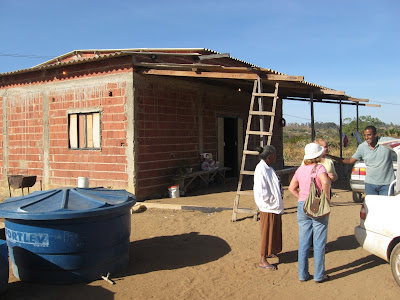The removal process was a terrible event. The government brought in the police to force people out of their homes. At times children were alone in their homes, with their mother out to work. They still came and told the children to leave. And they began destroying homes right away with hammers. The government brought in trucks to carry away the dump generated with the home demolitions. Actually, the "move" of furniture and reusable construction materials were often mixed with dump of demolitions. So most people lost their furniture too. Moreover, the government brought in jailed criminals to work on the removal, which was strictly forbidden in the Brasília Sustentável plan. Friends of mine at Monjolo later on spoke to me of seeing "movers" stealing furniture at the date with the help of local residents.
Joaquim showed to me the 48 hour "notice" that the government "served" them with to leave their homes. It had 2 sentences that didn't say much. It didn't say why they had to leave. It wasn't signed by a judge - and it had to be. It didn't say how long they were to be displaced. It didn't say where they were to go. And of course it didn't mention anything about their rights.
I heard a man saying that he spent more than R$ 15 000 on his home. Considering the minimum wage is R$ 510, if he earned 2 minimum wages and put 1 minimum wage monthly toward his house, it would have taken him 2 years and a half to build it. That is, the government likely took away at least 2 years and a half of his earnings, not counting the value of the land!
The government employees also told them (including the children who were home alone)that the sewage work was urgently necessary. That there was a huge storm in the forecast for the following day that was going to wash them away and kill them all. And that they had to leave immediately.
This was July 2008.
The original plan was for the government to build a number of houses within Cidade Estrutural prior to the removal, and for these families to move there. The houses were not ready, however. There was another important problem with the houses: they were built next to the garbage dump. When it rains, liquid residue flowed from the garbage dump to the houses, flooding them with smelly waste. Also, the houses were very small. Many families had more than 6 members. Later on in 2010, a local association went to justice against the government, against the move to these houses. An inspection was performed by justice officials and technicians. They determined that no one could live under those conditions, and justice vetoed the houses.
Still at Estrutural, some of the families were forcibly put on the "social rental" program of the government. However, the government paid their rentals whenever they wanted, that is, once in a while. So often these families were expelled by landlords 3, 4 times. I knew a woman who moved 8 times with the "social rental" program! Today she suffers from severe depression. She - and a number of families - are traumatized with the whole story.
Back to July 2008, these 40 families were removed to a "temporary" place called Monjolo. They put them under sailcloth.
See also
Part 1
Part 3
Part 4







